|
|

|
Porsche, and the Porsche crest are registered trademarks of Dr. Ing. h.c. F. Porsche AG.
This site is not affiliated with Porsche in any way. Its only purpose is to provide an online forum for car enthusiasts. All other trademarks are property of their respective owners. |
|
|
 Model Specific Information
Model Specific Information
914/4: 70 71 72 73 74 75 76 914/6: 70 71 72
  |
| wonkipop |
 Aug 5 2024, 01:23 AM Aug 5 2024, 01:23 AM
Post
#141
|
|
Advanced Member     Group: Members Posts: 4,720 Joined: 6-May 20 From: north antarctica Member No.: 24,231 Region Association: NineFourteenerVille 
|
stumbled across a you-tube japanese car dealer vid from a few years back.
was a very original 1970 or 71 1.7. shots of interior verified it as j apec. had the metric speedo (km) with the red warning band at 50-60km/hr as per early cars. also the pure red emergency flasher button. central dash air vent and smooth textured door cards. car had euro style split color front indicator lenses with j spec warts (vertical striations in lens casting). also had VW porsche rear panel badge and no porsche lettering on engine grille. very well preserved car. they are still out there, even in Japan. engine is marked 022.6 as per USA cars. and also has EA311 code stamp as per some early 1970 USA cars. it seems consistent that a lot of cars early in the production runs of all the different engines are stamped with the EA and then a three digit number. different three digits for the EA/EB 1,7, EC 1.8 and 2.0 engines with this EA code. lacks the M code stamps that USA engines had denoting the north american emissions package (basically hooks up fan casting for evaporative emissions system). i would guess that this J spec 1.7 engine from 70 and 71 is identical to the european engines which probably generally had only the 022.6 stamp on them. Japan did not introduce evaporative emissions controls until 1973. 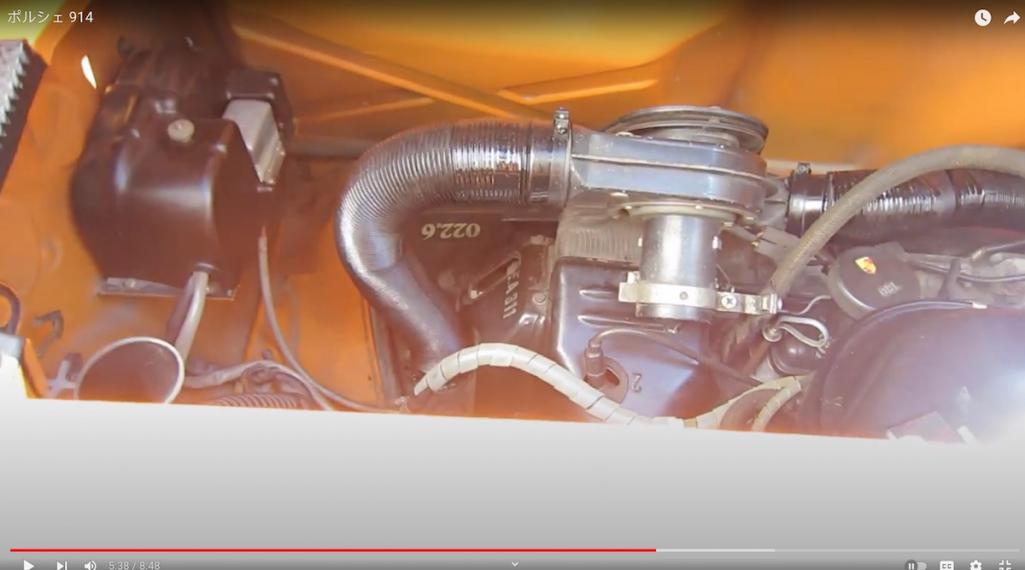 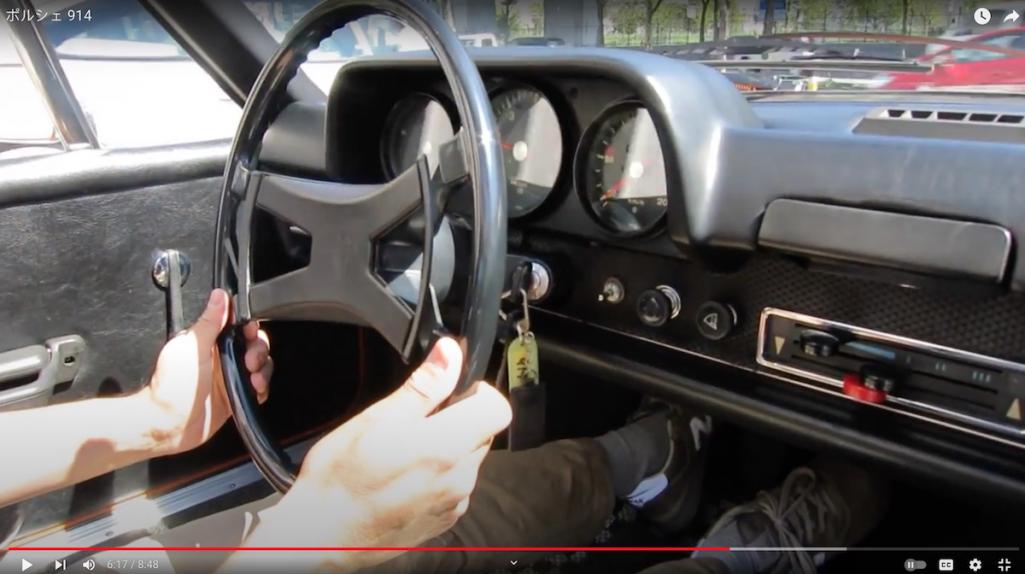 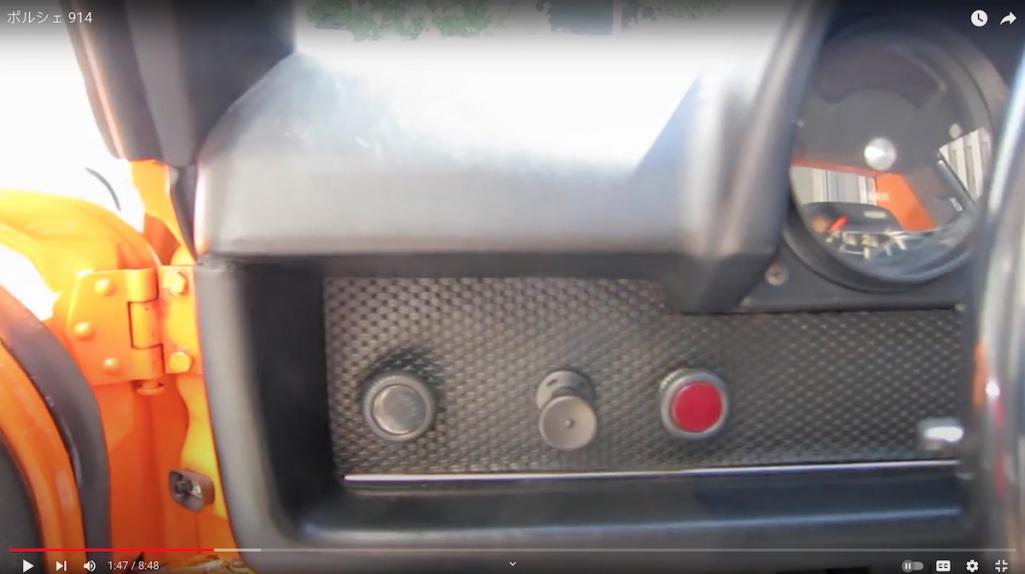 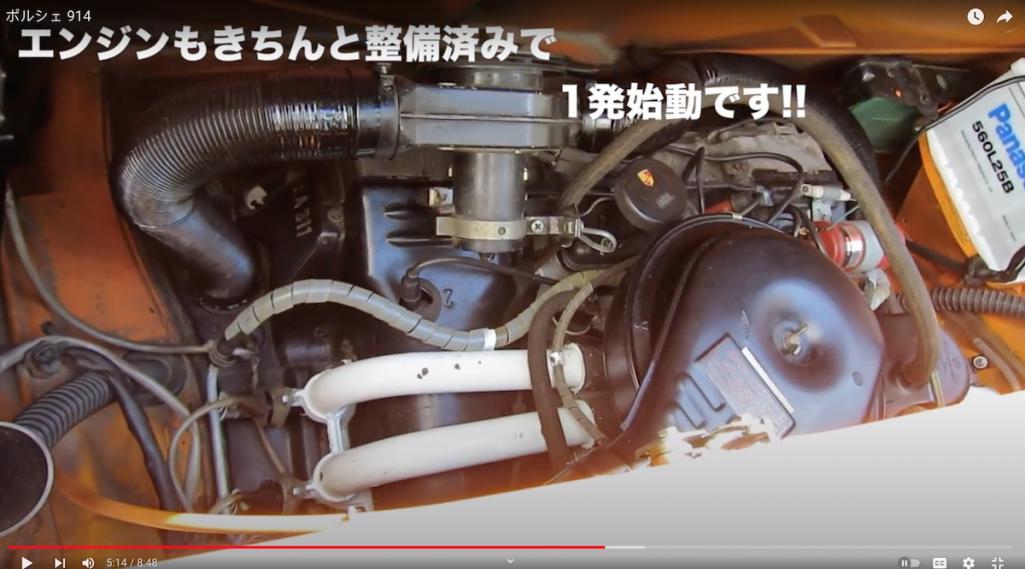 |
| krazykonrad |
 Aug 14 2024, 12:23 PM Aug 14 2024, 12:23 PM
Post
#142
|
|
Senior Member    Group: Members Posts: 1,144 Joined: 21-February 06 From: Canton, GA Member No.: 5,610 |
Is there a way, with any certainty, to determine what tin stamp/writing a 914 should have on it for purposes of restoration?
|
| wonkipop |
 Aug 14 2024, 03:24 PM Aug 14 2024, 03:24 PM
Post
#143
|
|
Advanced Member     Group: Members Posts: 4,720 Joined: 6-May 20 From: north antarctica Member No.: 24,231 Region Association: NineFourteenerVille 
|
Is there a way, with any certainty, to determine what tin stamp/writing a 914 should have on it for purposes of restoration? yes - see chart previous page - towards bottom of page. all the USA market cars/all years are accounted for. at least in terms of the main three digit code numbers. however sometimes that was stamped on left side, sometimes on right. not enough examples of any particular year to identify cut off points or date clusters for one or the other side. some engines also bore the code EA followed by a particular three digit code depending on the engine type. thats harder to know with absolute certainty. only early engines in production runs seem to have that. but no specific data to give a cut off point. the EA code numbers are known for each particular engine type - and it could stamped on the opposite side of the engine from the main three digit code stamp if it was there or above the three digit code on left hand side or right hand side. would depend on the engine type and the year of car. also some engines bore the stamp IO - meaning in order. but again not all engines. possibly applied to engines with a fault corrected. finally some 1.8 engines also had a P underneath the three digit main code number. unknown fully what that meant or the extent to which engines it applied to. not enough data. only a couple of examples out of the many on file. but you can with confidence place the main three digit code number that applies for any engine using the chart. and if you put it on the left hand side of engine tin in standard position (see various photos) you would have the minimum that every engine had in the most commonly found position. if you know what your car is, year and model i can guide you to what the engine stamp numbers are and what is commonly the location. |
| krazykonrad |
 Aug 15 2024, 12:07 PM Aug 15 2024, 12:07 PM
Post
#144
|
|
Senior Member    Group: Members Posts: 1,144 Joined: 21-February 06 From: Canton, GA Member No.: 5,610 |
Thanks for the reply and for all the hard work you have put into this. I have a 72 base (no appearance package) with a 1.7 originally in it. When I bought it, it had a 2.0 GA code engine in it. I still have the 2.0. It just needs to go back in.
|
| wonkipop |
 Aug 15 2024, 02:33 PM Aug 15 2024, 02:33 PM
Post
#145
|
|
Advanced Member     Group: Members Posts: 4,720 Joined: 6-May 20 From: north antarctica Member No.: 24,231 Region Association: NineFourteenerVille 
|
Thanks for the reply and for all the hard work you have put into this. I have a 72 base (no appearance package) with a 1.7 originally in it. When I bought it, it had a 2.0 GA code engine in it. I still have the 2.0. It just needs to go back in. reasonably easy for 72 MY number for the 1.7 for USA (inc calif) = 610 number for the 2.0L engine (73/74 MY) = 621 most common location of the stamp number in all examples i have come across is on left hand side engine tin. 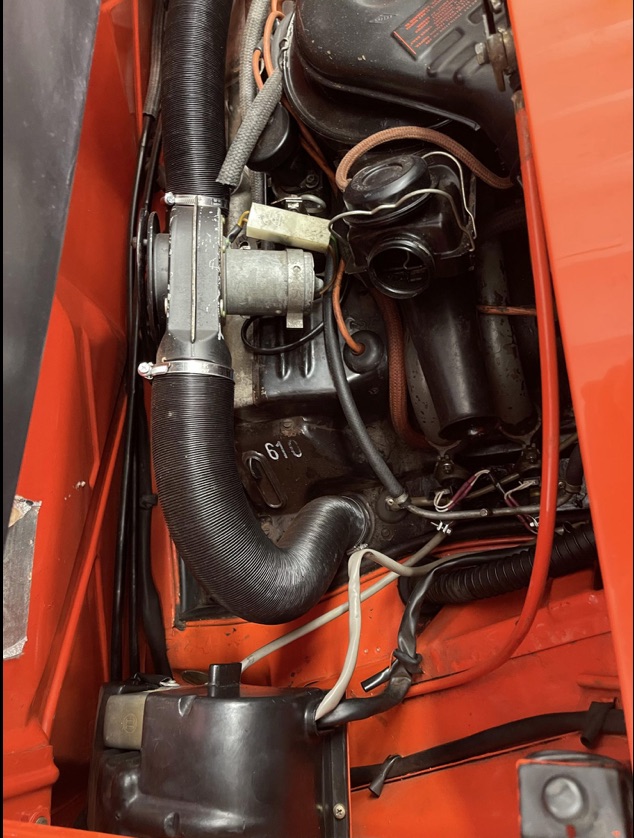 it was also fairly common to see it stamped on right hand side. similar spot. 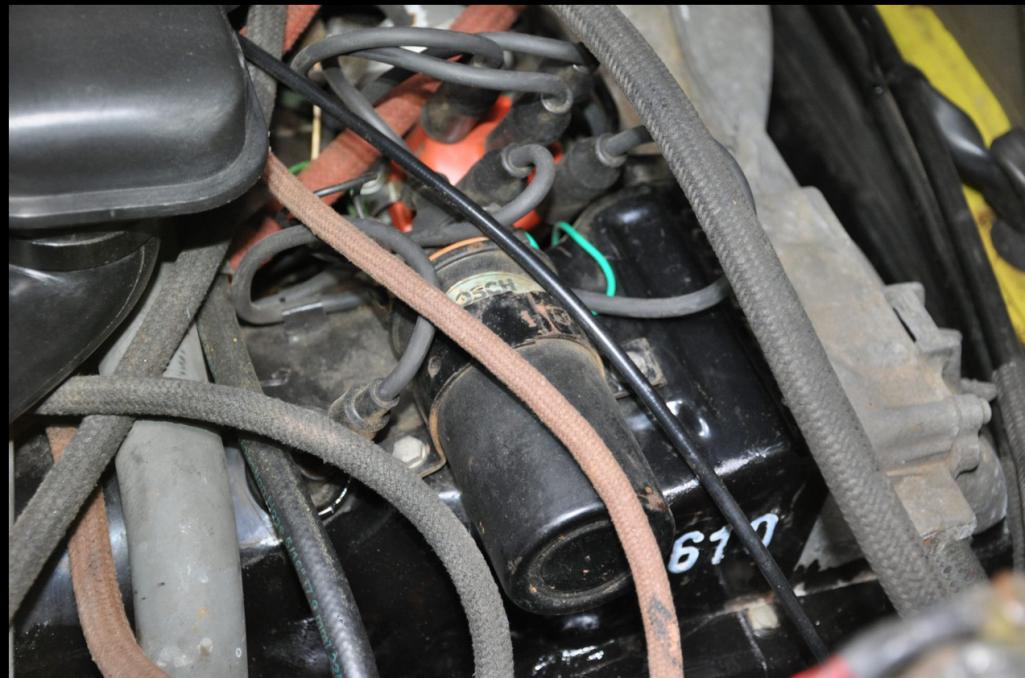 |
| wonkipop |
 Aug 15 2024, 03:27 PM Aug 15 2024, 03:27 PM
Post
#146
|
|
Advanced Member     Group: Members Posts: 4,720 Joined: 6-May 20 From: north antarctica Member No.: 24,231 Region Association: NineFourteenerVille 
|
@JeffBowlsby
i have been giving this one that you collected and is on your website a bit of thought mr. b i have not come across another 1.8 like it. with the P designation. you would think you might if it was something that had to mark out the engine in someway if it was related to a relatively common accomodation of equipment as a production line measure for assembly of the car. 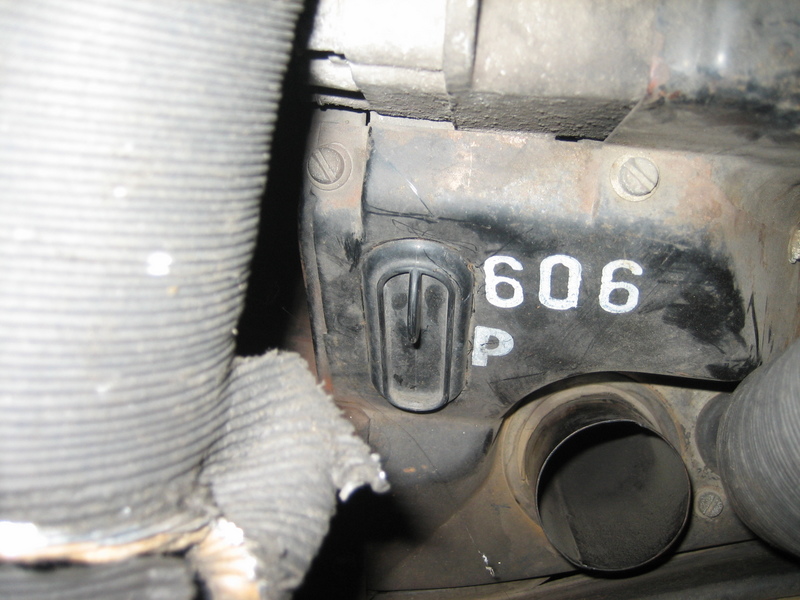 nor have i come across the P for any of the other engines of any other year fitted to 914s. 606 means its a standard 74 EC-A (California emissions) for a car with a standard sump lid for a non appearance group 1.8 without the console and gauges. remembering that beginning with 74 the small engine models could be ordered with an appearance group package from the factory that was virtually identical to the 2.0 appearance group. i have the feeling the P might mean this. 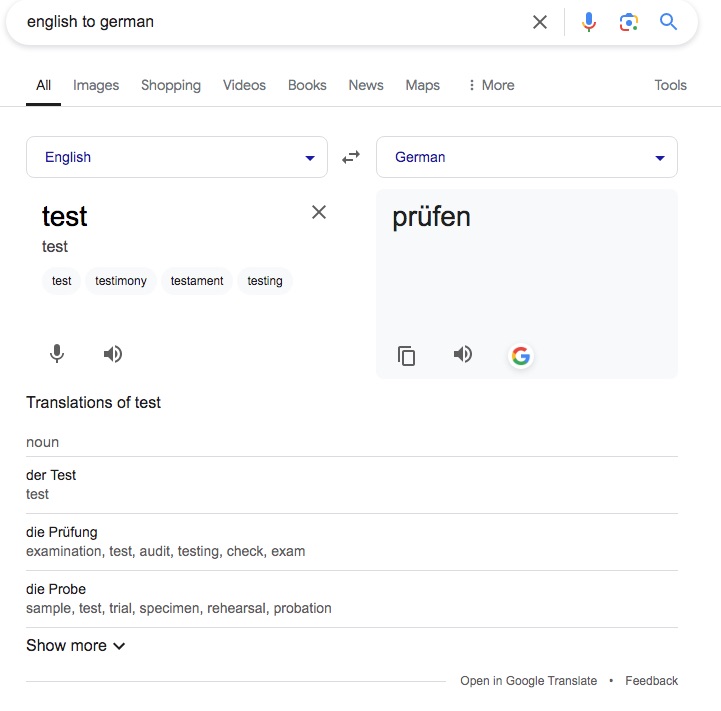 obviously this is pure speculation. but i do have a reason for suggesting it. there was a lot of fuss around VW and USEPA/CARB certification for the 1974 model year cars stemming from an emissions cheat controversy surrounding the 1972/73 VW model range. there is also evidently some lack of clarity with the EC engines and their emissions stickers with the curious labels that state USEPA and California conforming for both engine variations (EC-A and EC-B). which is odd given we have confirmed with sales data the EC-B engines were 49 states and EC-A engines were California. Also we finally found that EC-B emissions sticker that was revised to say an EC-B was only USEPA conforming done for the last month of production. I also came across EPA literature when i was researching the EC-B engines 3 years back that indicated how the cars were certified. the manufacturers were required to run a small fleet of cars which the USEPA monitored with a very specific test procedure. i wonder if this engine might have belonged to the test fleet that VW north america would have run. either for CARB or for EPA certification conformation. After they were finished with it - it might have been onsold to a customer as similar to a dealer demonstrator car. there is certainly no reason to have distinguished the 1.8 engines for production line purposes other than for either the USEPA version or the california version and further to that for either appearance group or standard version. which casts a light on the various EA + three letter code found on some engines of all types and years which on the info i have collected definitely seems restricted to very early production examples of each different variation of engines that went into the cars. are those EA+ number stamped engines also cars that were once part of a fleet monitored for certification purposes? given that EA means more of less "development program". the unique P stamp on the EC-A engine may have come about as a late accomodation of the engine into a test program for CARB. there is definitely something odd about the small difference and modification that was done to the EC engines in order to have them meet CARB standards. the emissions labels point to that. its entirely possible that the EC-A engines destined for fleet monitoring were given a late in the process special designation to identify them. i can see why the factory might have sought to designate these particular engines with special identification. they would have been assembled to the highest levels of tolerance and accuracy for obvious reasons. the engines would have went into cars with vins earmarked for that specific use, not general sales? anyway? i suspect if this was the case then the only other place the P might be found would be on some early production run examples of the 1974 VW 412 fitted with its own variation of the california EC engine. |
| JeffBowlsby |
 Aug 15 2024, 04:42 PM Aug 15 2024, 04:42 PM
Post
#147
|
|
914 Wiring Harnesses & Beekeeper      Group: Members Posts: 8,862 Joined: 7-January 03 From: San Ramon CA Member No.: 104 Region Association: None 
|
Could be, its plausible. Its speculation at this point but its an interesting thought.
|
| wonkipop |
 Aug 16 2024, 04:26 PM Aug 16 2024, 04:26 PM
Post
#148
|
|
Advanced Member     Group: Members Posts: 4,720 Joined: 6-May 20 From: north antarctica Member No.: 24,231 Region Association: NineFourteenerVille 
|
Could be, its plausible. Its speculation at this point but its an interesting thought. i'll see if i can dig up the item i found in research describing what the manufacturers were required to do, first of all in terms of certifying the engines and then further to that maintaining the certification. there was something about having to provide a vehicle every X number of units from the production line that was to be monitored and tested to ensure the emissions systems worked at the required standards for the warranty period. 50,000 miles or 5 years. the USEPA put the vehicles through its test procedure which i also managed to find. it was a prescribed driving sequence after which and during which its exhaust gases were tested and measured. it got me thinking that possibly explains the engines with the additional EA + three letter codes only some engines seemed to get. as if they were special to the various design program names assigned to each particular engine type. these cars might also have been part of other testing programs run in relation to the cars. for instance the horst marchart car (74 1.8 euroo) that is now in the museum collection has the EA code stamped on it as well as the engine designation number 608. i suspect that information specifically about these codes would be found in the VW archives as it covers VW manufactured engines. unlikely to be in the porsche archives. for instance the current curator in charge of the porsche museum could cast no light on the stamped number on the marchart car and was genuinely surprised to find out about it. i know i have an image somewhere in my files of a VW beetle engine which has an EA code stamped on its engine tin. but not every beetle engine had it. it also seems to have been used throughout the VW engine range. |
| JeffBowlsby |
 Aug 16 2024, 06:37 PM Aug 16 2024, 06:37 PM
Post
#149
|
|
914 Wiring Harnesses & Beekeeper      Group: Members Posts: 8,862 Joined: 7-January 03 From: San Ramon CA Member No.: 104 Region Association: None 
|
I wonder if EA is an acronym for something like the IO stamp?
Ein A....? Wish I knew German. |
| wonkipop |
 Aug 17 2024, 02:12 AM Aug 17 2024, 02:12 AM
Post
#150
|
|
Advanced Member     Group: Members Posts: 4,720 Joined: 6-May 20 From: north antarctica Member No.: 24,231 Region Association: NineFourteenerVille 
|
I wonder if EA is an acronym for something like the IO stamp? Ein A....? Wish I knew German. (IMG:style_emoticons/default/biggrin.gif) (IMG:style_emoticons/default/biggrin.gif) wish i could crack the last bit of the mystery with these additional and occasional engine stencil stamp numbers. (IMG:style_emoticons/default/biggrin.gif) (IMG:style_emoticons/default/biggrin.gif) i'd have to get into the VW archives. maybe a late retirement project. i should go for a trip to germany. never been. given i have german ancestry on my mothers side its a bit lacking of me. i think i have gone as far as i can go with whats available from sales documentation. still, with all the photo documentation of cars on the internet these days its been possible to advance research in a way you could never do in the 20th century. (IMG:style_emoticons/default/beerchug.gif) |
| wonkipop |
 Aug 19 2024, 09:34 PM Aug 19 2024, 09:34 PM
Post
#151
|
|
Advanced Member     Group: Members Posts: 4,720 Joined: 6-May 20 From: north antarctica Member No.: 24,231 Region Association: NineFourteenerVille 
|
I wonder if EA is an acronym for something like the IO stamp? Ein A....? Wish I knew German. I am fairly certain the EA is the generally accepted anachronym for development order, ie design project number. Entwicklungsauftrag. and i am fairly sure it means the same thing on the engine stamps. the EA numbers i have for the engines when the EA stamps appear are as follows. EA 311 1970 MY 914s. (example USA market car and Japan market car). EA349 1973 MY 914 2.0 (USA model car) EA 356 1973 MY 914. 1.7 (examples USA model car). EA 370 1974 MY 914. both 1.8 and 2.0 (examples USA model cars). EA 381 or EA 391 1975 MY 914 1.8. (this was smudged - difficult to read mid number) i'd stab a guess that the 75 2.0L also had this EA number as it was an update and modification of the 74 engines for emissions and ikely have followed similar practice to the 74 stamps being the same on both engine types. interestingly EA311 was the design project number given at the commencement of what would become the type 4 (411) project. when it started it was conceived as a replacement for the type 3 VW but the proposal grew in size and became a bigger car by the time it reached production. the engine did not change a great deal hence why the early engines likely bear the original EA311 stamp number? ---------- this is my listing of the engine number stamps and other markings as it stands currently. 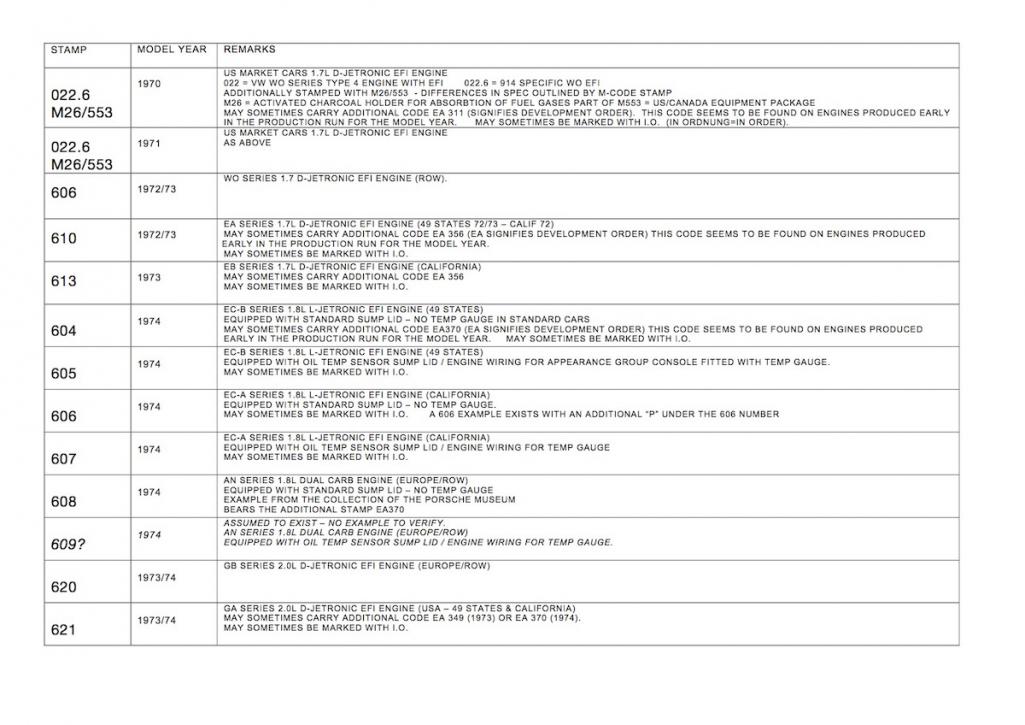 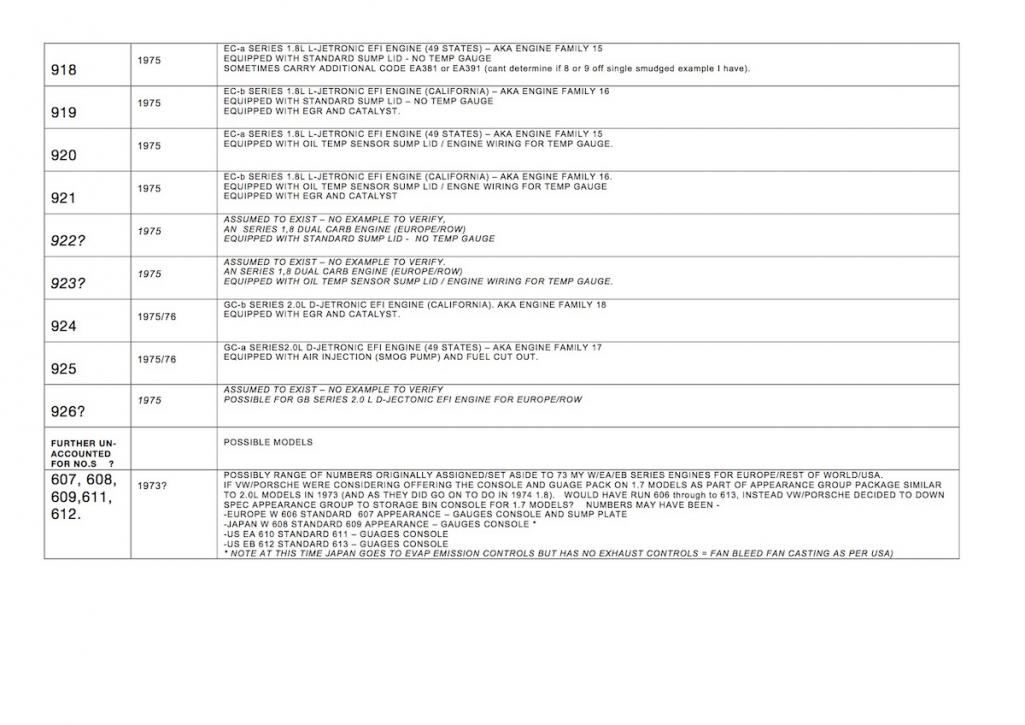 |
| wonkipop |
 Aug 19 2024, 10:09 PM Aug 19 2024, 10:09 PM
Post
#152
|
|
Advanced Member     Group: Members Posts: 4,720 Joined: 6-May 20 From: north antarctica Member No.: 24,231 Region Association: NineFourteenerVille 
|
this is some further information i gathered up from a 1973 European VW 411 owner.
its a build sheet for a 411. these were often taped to the doors of the cars as they were produced at the main VW plants. after the cars were completed they were taped to the springs under the rear seats where owners often found them. there would have been something similar at the Karmann Factory. By the time they were producing the 914, Karmann was under ownership by VW and was following VW production protocols and procedures. I'd love to see a build sheet for a 914 but i don't think they escaped the factory still in the car. at least no one has ever found one it seems. 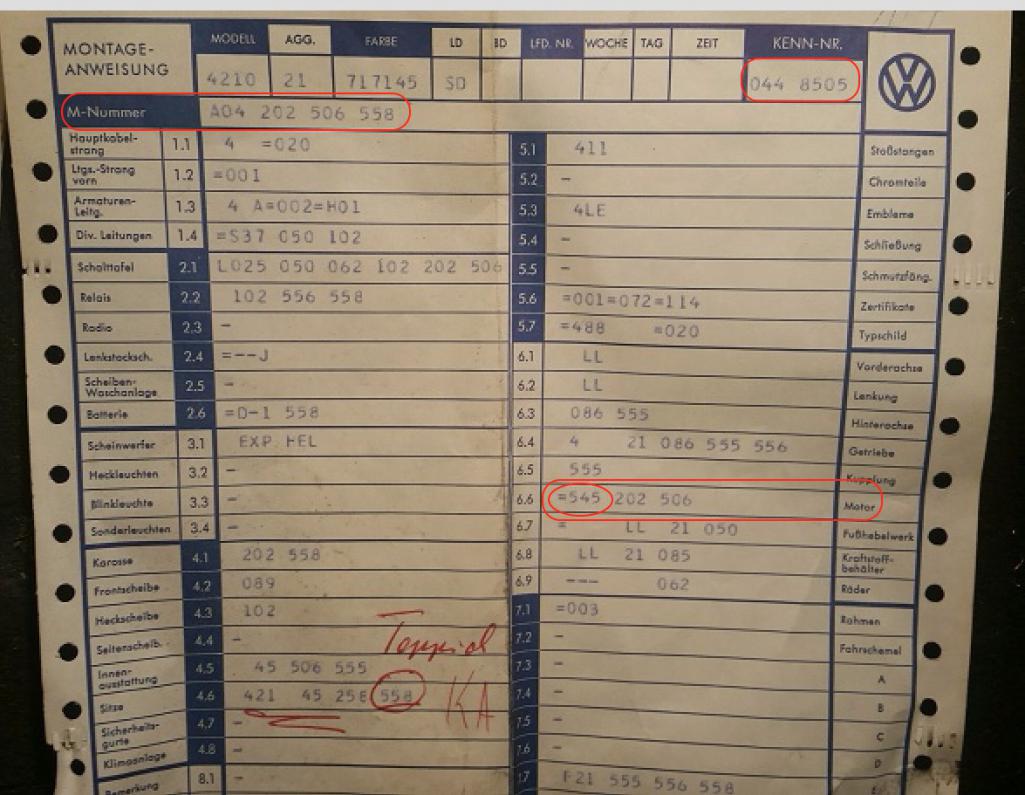 i can read quite a bit of this build sheet off the codes. I know its for a 1972 MY 411 european spec. under model it says 4210. = 4 door VW 411 L left hand drive. under Farbe (which means color) 7171 = maya metalllic 45 means black vinyl interior. i can read three of the 4 option (M Nummer) = M Codes. i don't know what A04 means. the other three are as follows. 202 is short for M202 = verstorkkle motorheitzung mit verstorktem heizluftgeblose. reinforced engine heating with additional heating air flow. ie heater fan blower with ducting in engine bay. 411s came standard without the fan blower unlike 914s. M506 = bremskraftverstorker brake booster. again standard 411s did not have the engine vacuum brake booster. M558 = zusorzlich 2 batteririe. dual batteries. apparently 411s could come with twin batteries. presumably for starting in super cold conditions? whatever you could fit dual batteries. of most interest to ideas of engine stamps is the listing under Motor. 545 202 506 this is the engine tin stamp off the same car. 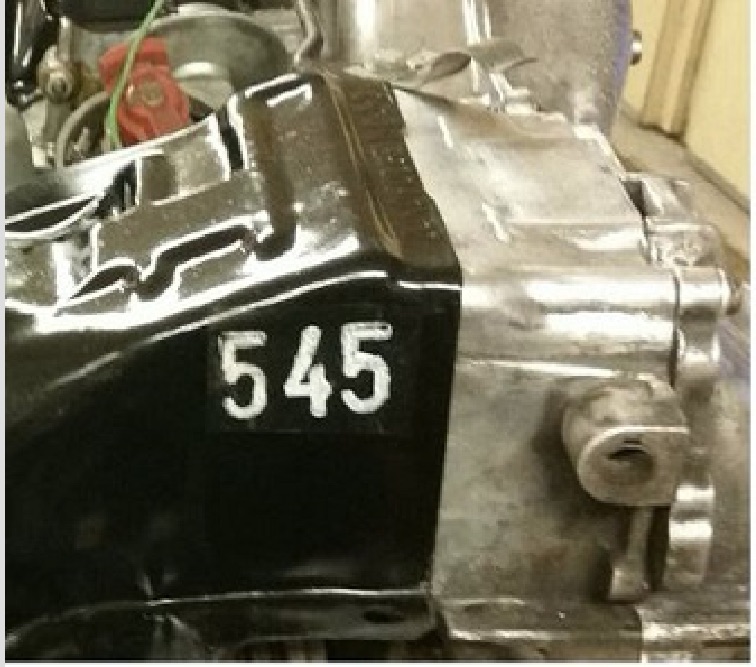 the engine stamp accords with the first three numbers noted on the build sheet. 545. the other two sets of three digit numbers are the M codes that would affect the engine install but not necessarily the engine as it came out of stock pile. 202 being the heater blower fan. this would be installed after engine install in car. in a 411 it is mounted a little differently than in the 914s as it is attached to the body work air inlet ducting not the engine itself. only the hoses connect to engine tin. 505 is the brake booster connectiong. presumably this was an engine vacuum hose connection to a port on the enigine. don't know exactly as i have never seen one and of course 914s did not have brake boosters. interestingly M202 and M558 is picked up in the body work listing. Karosse. 202 and 558 are listed. I can see why as i have seen an australian 411 which also never had the engine bay fan booster. the circular hole in the engine intake air duct that the fan would couple to is blocked by a rivetted in circular cover. so the body would have come to the production assembly line with this hole either open or closed dependent on the M202 option. don't really know about the provision for twin batteries but presumably this also afffected the raw delivered body shell in some way. the build sheet also notes the KENN NR. at top right hand corner. often called the Karmann Number by 914 owners. really its the VW production number assigned to all VWs during that time period. car carried it for the purposes of production according to the build sheet (Customer order) before it was completed and received VIn. the 4th number is interesting. its an 8 where 914s have a 9. i believe the 8 signifies the Satzlinger Plant where production of 411s and 412s was done. i think from memory the 1 in that position signifies Wolfsburg and 6 signifies Embden. all type 4 engines were made at the Hannover plant. so they would have all needed to be stamped with some kind of identification for production line placement and other factories they were shipped to where the varying cars were finally assembled. i'll bet if anyone ever turned up a build sheet for a karmann ghia or a beetle cabriolet that the 914s had the same build sheet. its highly likely it was either the same as the example i have posted above or very similar. the build sheet i have posted looks like its computer generated. those of us old enough would recognise the sides of the page with the punched out holes. its out of vintage IBM style 1960s / 70s mainframe. VW did have those IBM mainframes at its major plants but its possible that karmann did not - it may have used different stationary. anyway. if you could ever find one of those build sheets i have no doubt the white engine stamp numbers would be there listed on the build sheet for the particular car. some images of beetles, buses and type 4s on assembly line at other VW plants. you can see the build sheets taped to the side of the cars. photos i have seen from karmann appear to show they did not follow the practice of taping the build sheet to the cars in those locations. 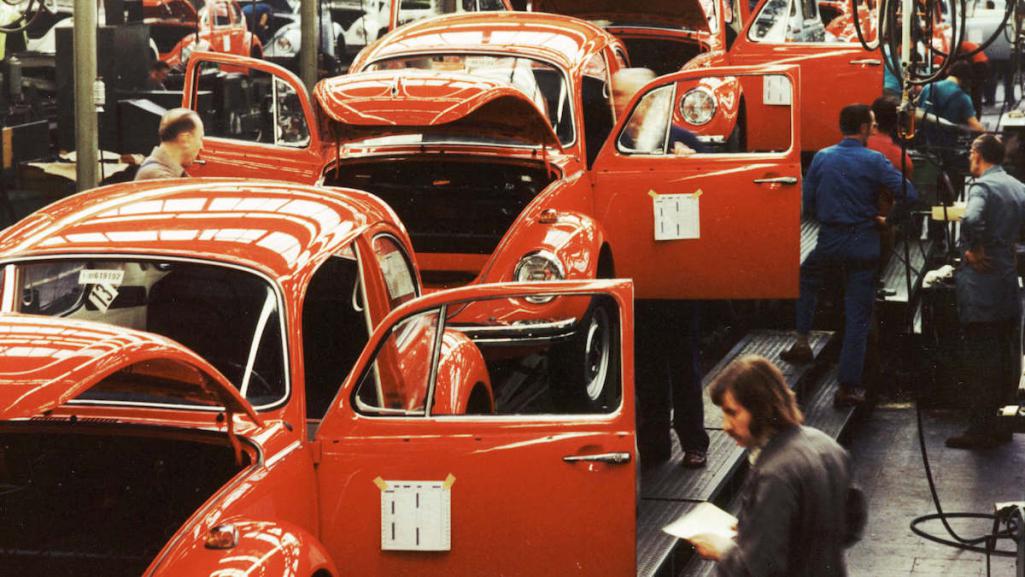 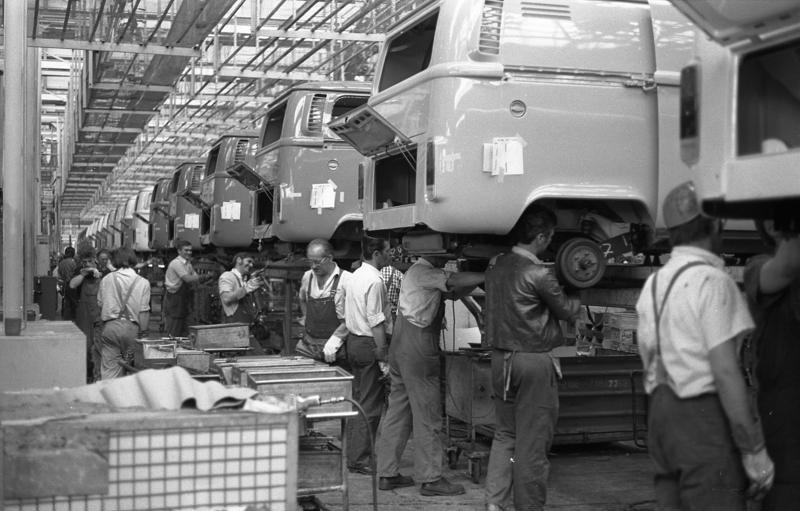 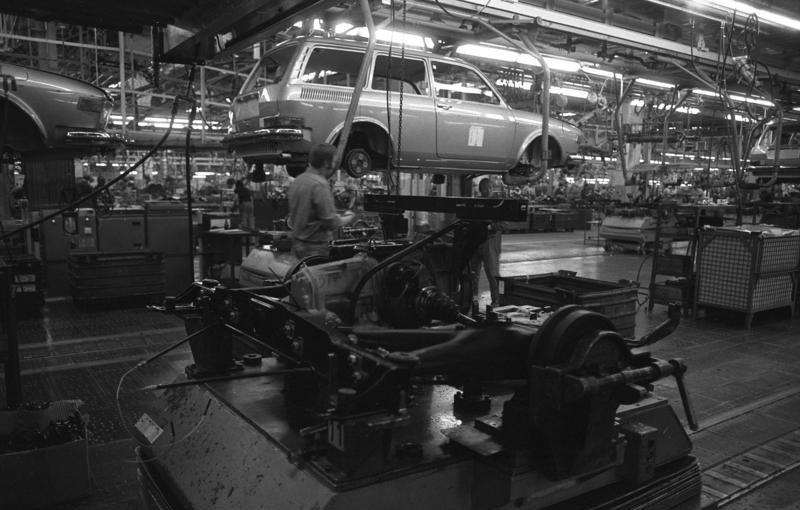 |
  |
1 User(s) are reading this topic (1 Guests and 0 Anonymous Users)
0 Members:

|
Lo-Fi Version | Time is now: 31st March 2025 - 05:14 PM |
Invision Power Board
v9.1.4 © 2025 IPS, Inc.









